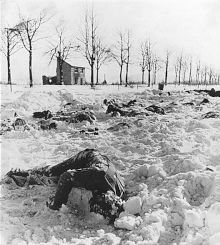Malmedy trial
The Malmedy process was a war crimes trial , which under the Dachau trials before a US military court against 73 accused German from 16th May bis 16th July 1946 in the internment camp Dachau took place. All of the defendants were found guilty. In addition to 43 death sentences , 30 prison sentences were imposed. The death sentences were not carried out.
course
process
In the trial, 73 members of the tank regiment of the 1st SS Panzer Division Leibstandarte SS Adolf Hitler were accused, 77 US soldiers captured near Malmedy were shot in the so-called Malmedy massacre in December 1944 and, until the end of the Ardennes offensive, alone in the area of Stavelot To have committed 130 murders of civilians (men, women and children).
At the trial, defense attorney Rudolf Aschenauer claimed that the defendants had been forced to make incriminating statements and had been mistreated . The German defense lawyers were not given any insight into the interrogation files. 51 soldiers later signed affidavits claiming they were tortured during interrogation.
Judgments
- 43 soldiers to death by hanging , including SS-Standartenführer Joachim Peiper ,
- 22 to life imprisonment, including SS-Oberstgruppenführer Sepp Dietrich ,
- Two to twenty years in prison
- One to 15 years in prison
- Five to ten years in prison.
The political aftermath
Mostly civilly motivated American citizens in and outside the Army insisted that allegations of legal violations and unfair machinations must be properly clarified. A US Commission of Inquiry was unable to confirm the torture allegations but found that the preliminary investigations had not been carried out correctly. During the investigation, some Americans who were bitter about the murders of the prisoners of war, allowed themselves to be mistreated and intimidated. When doubts about the results of such investigations, the commission based its opinion that no death sentences should be carried out. This called the legality of the procedure into question. Right-wing political circles in the United States used these allegations to agitate against the law enforcement program of the American occupation authorities and against the policies of the Truman administration, which were allegedly infiltrated by communists . Senator Joseph McCarthy exploited the Malmedy issue for his career.
All death sentences were later commuted to prison terms, so there were no executions related to the Malmedy Trial . In April 1948 the first convicts were released from the Landsberg War Crimes Prison . At the end of 1953 32 and at the end of 1954 there were still ten convicts in prison. Most recently, Georg Preuss (November 30, 1956), Peiper (December 22, 1956) and the Austrian Hubert Huber (January 29, 1957) were released.
Peiper's former chief prosecutor of the US Army, Ellis, later even attested that word had got around in America that the Malmedy trial, which took place in an atmosphere of hatred, vindictiveness and retribution, was not entirely in accordance with the law be. In the preliminary investigation, the 74 accused SS soldiers were forced to confess through physical and psychological torture.
The judgments and the proceedings of the Malmedy trial, combined with the allegations of torture, are still a topic of right-wing and right-wing extremist propaganda , including on the Internet.
See also
literature
- Robert Sigel: In the interests of justice. The Dachau war crimes trials 1945–1948 . Campus-Verlag, Frankfurt am Main / New York 1992, ISBN 3-593-34641-9 .
Web links
- Description of the process and its background in the "Jewish Virtual Library" (English)
- Jewish Virtual Library, United States v. Valentin Bersin, and al., Case no. 6-24, Review and recommendations of the Deputy Judge Advocate for war crimes, October 20, 1947 (English) jewishvirtuallibrary.org (PDF; 41.8 MB)
- Malmedy massacre Investigation - Report of the Subcommittee of Committee on armed services - United States Senate - Eighty-first Congress, first session, pursuant to S. res. 42, Investigation of action of army with respect to trial of persons responsible for the massacre of American soldiers, battle of the Bulge, near Malmedy, Belgium, December 1944, October 13, 1949 (English)
Individual evidence
- ↑ James J. Weingartner: Crossroads of Death. The Story of the Malmédy Massacre and Trial . Berkeley / Los Angeles / London 1979, p. 121ff.
- ^ Jens Westemeier : Himmler's warriors. Joachim Peiper and the Waffen-SS in the war and the post-war period (= War in History, Volume 71) Schöningh, Paderborn 2014, ISBN 978-3-506-77241-1 , p. 856 f.
- ↑ Karl-Heinz Janßen : Death caught up with him . In: Die Zeit , No. 31/1976


